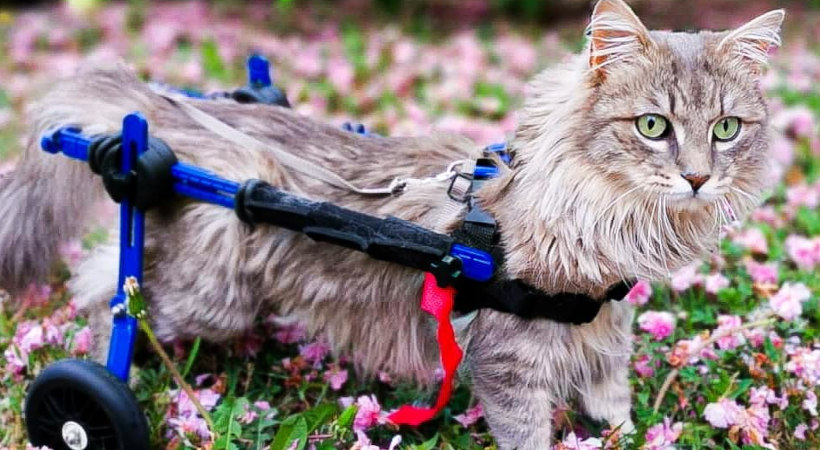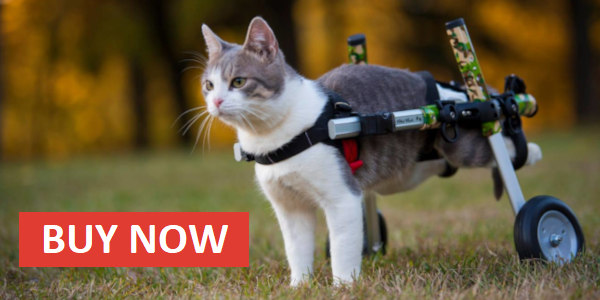- October 25, 2023
Litter Box Solutions for a Mobility-Impaired Cat

Living with our feline companions requires understanding and catering to their health and comfort needs, especially when dealing with cats with mobility impairments. Mobility issues can result from various causes, such as aging, injury, or health conditions, and can significantly impact a cat’s quality of life. It extensively influences their use of the litter box, a critical element of daily feline functioning.
In such situations, furniture explicitly designed for mobility-impaired cats can provide a creative and efficient solution.
Mobility-Impaired Cats: Understanding Their Needs
Mobility-impaired cats encompass various conditions, including arthritis, paralysis, amputations, and more. Each cat’s needs will vary, but they face some common challenges when it comes to using a traditional litter box:
1. Limited Mobility
- Arthritis: Painful joints can make it difficult for cats to climb in and out of standard litter boxes.
- Paralysis or amputation: Cats with paralyzed limbs or amputated legs may struggle to balance or dig in a traditional litter box.
2. Special Assistance
- Blindness: Blind cats may need tactile cues or specific scent markers to locate the litter box.
- Deafness: Deaf cats may not hear the typical sounds associated with using the litter box, making visual cues essential.
3. Stress Reduction
Mobility-impaired cats often experience stress related to their limitations, which can be exacerbated by struggling with a standard litter box setup.
Why Consider Specialized Furniture for Mobility-Impaired Cats?
Conventional litter boxes often feature high walls or entrances that can be difficult to navigate for impaired cats. To overcome these barriers, litter box furniture for cats designed for mobility-impaired cats incorporates modifications that cater to cats facing mobility issues. These variations provide a seamless passage in and out of the box, offer sufficient interior space to accommodate the cat’s movements comfortably, incorporate stable surfaces to ensure balance, and are visually pleasing.
Features and Considerations for Mobility-Friendly Litter Box Furniture
When looking for furniture to accommodate mobility-impaired cats, consider the following features:
1. Lower entrance and sufficient space:
Cats with mobility issues may drag their hind legs or have difficulty navigating vertical structures. Therefore, furniture suitable for them should have a lower, easily accessible entrance and enough space inside for comfortable maneuvering.
2. Non-slip surface:
The interiors and entry points must have a non-slip surface to prevent accidents. Immobile cats often struggle with balance and coordination. Ensuring they can comfortably walk in and out of the litter box without slipping or tripping helps promote their independence.
3. Ease of cleaning and maintenance:
The furniture should have removable or openable sections that allow for easy cleaning and litter changes. It should also be of a material that absorbs minimal odor to keep your home environment fresh.
The Psychological Impact
Investing in specialized furniture for your mobility-impaired cat goes beyond simple convenience. It significantly boosts their morale by preserving their independence and fostering a sense of dignity. Additionally, ensuring their comfort in such essential aspects of their daily life is integral to their overall emotional well-being. It makes them feel cherished, accommodated, and necessary while shaping an environment that respects their needs and cultivates positive self-esteem.
DIY Furniture for Mobility-Impaired Cats
If you are crafty or want a more personalized solution, you can create furniture for your mobility-impaired cat. Here’s an essential guide to get you started:
Materials Needed:
- A piece of furniture (e.g., cabinet, end table)
- Saw
- Drill
- Screws
- Latch or magnet closure
- Sandpaper
- Primer and paint
- Cat litter tray or liner
Steps:
- Find a piece of furniture that suits your space and can accommodate the litter box dimensions.
- Remove any doors or drawers and sand the surface for painting.
- Cut an entry hole in one of the sides depending on the size of your cat and their mobility issues. Ensure its low enough for easy access.
- Drill small holes near the top or back of the furniture for ventilation.
- Prime and paint the furniture to match your décor. Allow it to dry thoroughly.
- Place the litter tray or liner inside the furniture, ensuring it’s easy to access and remove for cleaning.
- Attach a latch or magnet closure to keep the furniture securely closed.
- Position the furniture in a quiet and accessible location for your cat.
Final Thoughts
Furniture designed for cats with mobility impairments offers a practical and caring solution for cat owners. It can dramatically enhance the quality of life for feline companions by ensuring their comfort and ease in performing routine tasks. Regardless of the space constraints or the severity of the cat’s condition, the right furniture can profoundly affect your cat’s life. After all, our ultimate aim should be to provide the cat with a life filled with love, respect, and dignity, which is one step in that direction.

Related Articles:
Tags
What do you think?
Related Articles

New Puppy Checklist: Gear You’ll Need for Your New Dog
Getting a new puppy is really exciting, but before you welcome them home, it’s important to prepare your space for them. Since puppies need a

How Big Do Mini Poodles Get? Vet Reviewed Average Weight & Growth Chart – Dogster
The information is current and up-to-date in accordance with the latest veterinarian research. Learn more » When you buy a Miniature Poodle, you might not

Can Police Dogs Smell Nicotine? Vet Verified Facts & Info – Dogster
The information is current and up-to-date in accordance with the latest veterinarian research. Learn more » While cigarette sales have been declining steadily for decades,

How Old Is 5 in Dog Years? Vet-Approved Guide to Each Size of Dog – Dogster
The information is current and up-to-date in accordance with the latest veterinarian research. Learn more » A common method for calculating a dog’s age is

